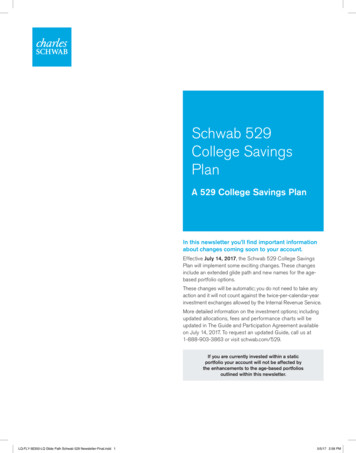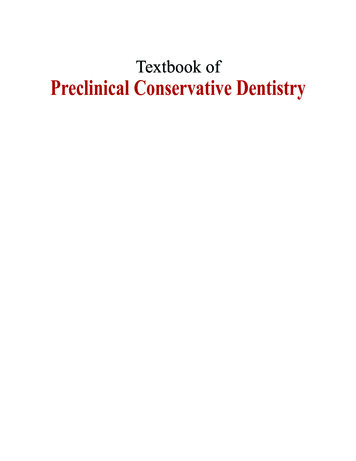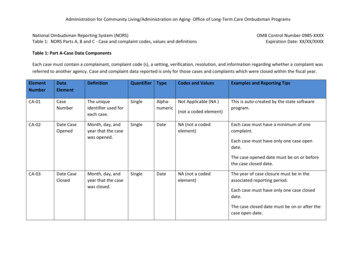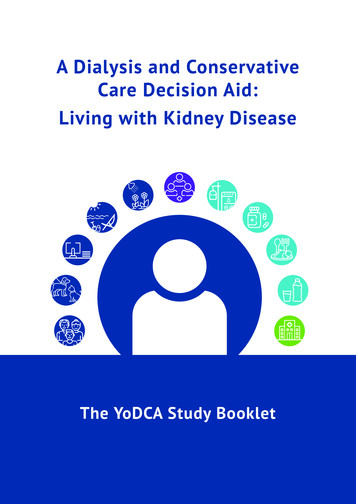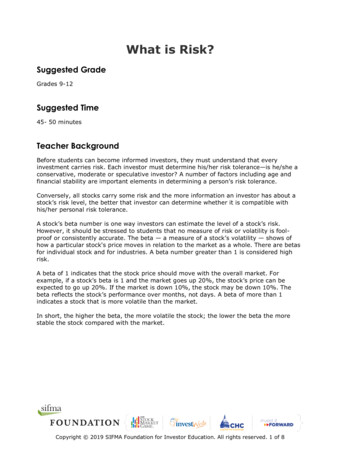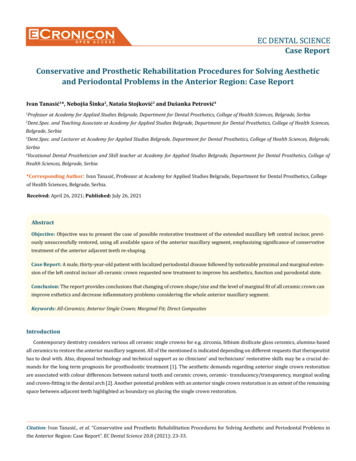
Transcription
CroniconO P ENA C C ESSEC DENTAL SCIENCECase ReportConservative and Prosthetic Rehabilitation Procedures for Solving Aestheticand Periodontal Problems in the Anterior Region: Case ReportIvan Tanasić1*, Nebojša Šinka2, Nataša Stojković3 and Dušanka Petrović41Professor at Academy for Applied Studies Belgrade, Department for Dental Prosthetics, College of Health Sciences, Belgrade, Serbia2Dent.Spec. and Teaching Associate at Academy for Applied Studies Belgrade, Department for Dental Prosthetics, College of Health Sciences,Belgrade, Serbia3Dent.Spec. and Lecturer at Academy for Applied Studies Belgrade, Department for Dental Prosthetics, College of Health Sciences, Belgrade,Serbia4Vocational Dental Prosthetician and Skill teacher at Academy for Applied Studies Belgrade, Department for Dental Prosthetics, College ofHealth Sciences, Belgrade, Serbia*Corresponding Author: Ivan Tanasić, Professor at Academy for Applied Studies Belgrade, Department for Dental Prosthetics, Collegeof Health Sciences, Belgrade, Serbia.Received: April 26, 2021; Published: July 26, 2021AbstractObjective: Objective was to present the case of possible restorative treatment of the extended maxillary left central incisor, previ-ously unsuccessfully restored, using all available space of the anterior maxillary segment, emphasizing significance of conservativetreatment of the anterior adjacent teeth re-shaping.Case Report: A male, thirty-year-old patient with localized periodontal disease followed by noticeable proximal and marginal extension of the left central incisor all-ceramic crown requested new treatment to improve his aesthetics, function and parodontal state.Conclusion: The report provides conclusions that changing of crown shape/size and the level of marginal fit of all ceramic crown canimprove esthetics and decrease inflammatory problems considering the whole anterior maxillary segment.Keywords: All-Ceramics; Anterior Single Crown; Marginal Fit; Direct CompositesIntroductionContemporary dentistry considers various all ceramic single crowns for e.g. zirconia, lithium disilicate glass ceramics, alumina-basedall ceramics to restore the anterior maxillary segment. All of the mentioned is indicated depending on different requests that therapeutisthas to deal with. Also, disposal technology and technical support as so clinicians’ and technicians’ restorative skills may be a crucial demands for the long term prognosis for prosthodontic treatment [1]. The aesthetic demands regarding anterior single crown restorationare associated with colour differences between natural tooth and ceramic crown, ceramic- translucency/transparency, marginal sealingand crown-fitting in the dental arch [2]. Another potential problem with an anterior single crown restoration is an extent of the remainingspace between adjacent teeth highlighted as boundary on placing the single crown restoration.Citation: Ivan Tanasić., et al. “Conservative and Prosthetic Rehabilitation Procedures for Solving Aesthetic and Periodontal Problems inthe Anterior Region: Case Report”. EC Dental Science 20.8 (2021): 23-33.
Conservative and Prosthetic Rehabilitation Procedures for Solving Aesthetic and Periodontal Problems in the Anterior Region:Case Report24Sometimes, a manipulation with this space by therapeutist is requested for successful therapy. The aim of this report was to present thecase of possible restorative treatment of the extended maxillary left central incisor, previously unsuccessfully restored, using all availablespace of the anterior maxillary segment, emphasizing significance of conservative treatment of the anterior adjacent teeth re-shaping.Case ReportA male, thirty- year-old patient with localised parodontal disease followed by noticeable proximal and marginal extension of the leftcentral incisor all-ceramic crown requested new treatment to improve his aesthetics, function and parodontal state (Figure 1). Patientdenied any trauma related to this condition nor systemic disease.Figure 1: Observation and inspection protocol during first visit of the patient.Incisor was previously endodontically treated and restored using fiber post. Patient was not satisfied due to obvious poor esthetic andgingivitis (Figure 2).Figure 2: Inflammation of the marginal gingiva leads to colour change of the anterior gum.Citation: Ivan Tanasić., et al. “Conservative and Prosthetic Rehabilitation Procedures for Solving Aesthetic and Periodontal Problems inthe Anterior Region: Case Report”. EC Dental Science 20.8 (2021): 23-33.
Conservative and Prosthetic Rehabilitation Procedures for Solving Aesthetic and Periodontal Problems in the Anterior Region:Case Report25Thus, patient requested to be re-treated in accordance with dentist suggestions. Also, a pathological movement of the maxillary leftcentral incisor toward vestibular was registered during standard clinical examination due to occlusal trauma. After clinical inspectionand laboratory treatment planning on models for analyzation, several negative sides of previously treatment were highlighted as of highpriority: poor composite fillings placed on proximal surfaces of the adjacent teeth, 11 and 22, and oversized maxillary left central incisorwith the consequent marginal inflammation and discoloration-lividity of the marginal gingiva (Figure 3).Figure 3: Gingival discoloration with oversized and movable left central incisor.Following clinical and laboratory steps were conducted: At first, all-ceramic crown and damaged fiber-post were removed and end-odontics was performed (Figure 4 and 5).Figure 4: Occlusal viewpoint of the tooth of interest with an old post removed.Citation: Ivan Tanasić., et al. “Conservative and Prosthetic Rehabilitation Procedures for Solving Aesthetic and Periodontal Problems inthe Anterior Region: Case Report”. EC Dental Science 20.8 (2021): 23-33.
Conservative and Prosthetic Rehabilitation Procedures for Solving Aesthetic and Periodontal Problems in the Anterior Region:Case Report26Figure 5: Labial viewpoint of the remaining incisor prepared for the new post and core build-up.A new RelyX fiber post size 2, with diameter of 1.6 mm (3M ESPE, Neuss, Germany) was made for left incisor. The fiber post made of3M ESPE was permanently cemented using RelyX U200 Automix resin cement (3M ESPE, Germany). A bulk fill composite Tetric Evoceramwith IVA colour signed (Ivoclar Vivadent, Germany) was used to restore the core (Figure 6).Figure 6: Restoration of the core using the bulk-fill composite.Citation: Ivan Tanasić., et al. “Conservative and Prosthetic Rehabilitation Procedures for Solving Aesthetic and Periodontal Problems inthe Anterior Region: Case Report”. EC Dental Science 20.8 (2021): 23-33.
Conservative and Prosthetic Rehabilitation Procedures for Solving Aesthetic and Periodontal Problems in the Anterior Region:Case Report27For this patient, it was recommended not to fabricate temporary crown to avoid overloading of already disassembled and shaky toothas to rehabilitate deteriorated marginal gingiva. Simultaneously with these procedures, adjacent teeth were conservatively treated usingTetric Evoceram A 3.5 dentin composite resin (Ivoclar Vivadent) due to basic colour of all anterior teeth in order to increase the interproximal dimension i.e. mesio-distal diameter, actually to decrease the space for left incisor (Figure 7 and 8).Figure 7: Composite filling removed from the mesial surface of the lateral incisor.Figure 8: Modulation of the proximal surfaces of the adjacent teeth using Tetric Evoceram composite material.Citation: Ivan Tanasić., et al. “Conservative and Prosthetic Rehabilitation Procedures for Solving Aesthetic and Periodontal Problems inthe Anterior Region: Case Report”. EC Dental Science 20.8 (2021): 23-33.
Conservative and Prosthetic Rehabilitation Procedures for Solving Aesthetic and Periodontal Problems in the Anterior Region:Case Report28In this way, a thin space between adjacent teeth, 22 and 11 will improve aesthetics of the anterior region with equalisation of both, leftand right maxillary incisors (Figure 9).Figure 9: A narrow space between adjacent teeth - incisal aspect of viewpoint.After tooth preparation, the anterior region of interest in the upper jaw was scanned using CAI segment (Scanner S600, Zirkonzahn,Germany) and then data were transferred to exocad software (Zirkonzahn, Germany) where the final contours of maxillary left incisorwere designed (Figure 10-12).Figure 10: Exocad labial viewpoint in central occlusion.Citation: Ivan Tanasić., et al. “Conservative and Prosthetic Rehabilitation Procedures for Solving Aesthetic and Periodontal Problems inthe Anterior Region: Case Report”. EC Dental Science 20.8 (2021): 23-33.
Conservative and Prosthetic Rehabilitation Procedures for Solving Aesthetic and Periodontal Problems in the Anterior Region:Case Report29Figure 11: Overlap of anterior teeth in exocad.Figure 12: Sagittal view of bimaxillary relationship in exocad.Finally, milling procedure was conduced using M5 Heavy metal milling unit (Zirkonzahn Modelier, Germany) and zirconia crown wasfabricated employing cut-back technique with Prettau Zirkonzahn zirconia (Figure 13 and 14).Citation: Ivan Tanasić., et al. “Conservative and Prosthetic Rehabilitation Procedures for Solving Aesthetic and Periodontal Problems inthe Anterior Region: Case Report”. EC Dental Science 20.8 (2021): 23-33.
Conservative and Prosthetic Rehabilitation Procedures for Solving Aesthetic and Periodontal Problems in the Anterior Region:Case Report30Figure 13: Cut-back technique with Prettau Zirkonzahn zirconia; frontal view.Figure 14: Cut-back technique with Prettau Zirkonzahn zirconia; lateral view.Immediately after the colour, size, shape and marginal sealing was checked, the crown was definitely modulated with faceted ceramicSopha for zirconia (Figure 15) and the crown was fitted in the right position and permanently cemented using resin composite cementRelyX U200.Citation: Ivan Tanasić., et al. “Conservative and Prosthetic Rehabilitation Procedures for Solving Aesthetic and Periodontal Problems inthe Anterior Region: Case Report”. EC Dental Science 20.8 (2021): 23-33.
Conservative and Prosthetic Rehabilitation Procedures for Solving Aesthetic and Periodontal Problems in the Anterior Region:Case Report31Figure 15: Cementation of the left incisor all ceramic crown.One month after the zirconia was cemented, the inflammation of marginal gingiva disappeared. Aesthetics of anterior maxillary seg-ment was obviously changed for the better which is confirmed by figures and patient satisfaction (Figure 16 and 17). However, certainlividity was found which is a consequence of trauma and the time is needed to complete rehabilitation procedure, if the same is achieved.Figure 16: One month after crown cementation.Citation: Ivan Tanasić., et al. “Conservative and Prosthetic Rehabilitation Procedures for Solving Aesthetic and Periodontal Problems inthe Anterior Region: Case Report”. EC Dental Science 20.8 (2021): 23-33.
Conservative and Prosthetic Rehabilitation Procedures for Solving Aesthetic and Periodontal Problems in the Anterior Region:Case Report32Figure 17: No signs of inflammation nor blood during inspection; tooth is embedded in the bone.Contusion of marginal gingiva was excluded through shallow position of the crown edge, enabling gingiva insertion toward the toothcrown compared to previous situation (Figure 18).Figure 18: Overall change shows different shape, size and marginal fit of left central incisor.Citation: Ivan Tanasić., et al. “Conservative and Prosthetic Rehabilitation Procedures for Solving Aesthetic and Periodontal Problems inthe Anterior Region: Case Report”. EC Dental Science 20.8 (2021): 23-33.
Conservative and Prosthetic Rehabilitation Procedures for Solving Aesthetic and Periodontal Problems in the Anterior Region:Case ReportDiscussion33In this case, dentists were used simple conservative and prosthetic procedures of changing shapes of adjacent teeth to obtain opti-mal space for incisor-crown placement. Inadequate composite fillings were removed, resized and reshaped to achieve harmony in theanterior teeth fitting. Prosthodontist did not hang down already prepared and a rounded shoulder margin nor significantly changed theangulation, just grinded the resin crown using fine diamonds burs around the tooth axis, to avoid secondary trauma of marginal gingivain the region of gingival gap [3,4]. Dentists did not fabricate temporary crown due to relieve stress in parodontal structures around leftcentral incisor to neutralize the eventual occlusal overloads and occlusal trauma.Additionally, this enabled marginal gingiva to return to normal physiological position before the first preparation-grinding, towardthe dental neck i.e. column dentist [5]. Crown margins are determined as the critical factor for aesthetics, adequate restoration strength,material support as for loads distribution, and if not properly considered it may lead to therapeutic failure [6].Adjustment of different levels, the marginal edge of all ceramics and the neck of natural adjacent tooth by setting both contours at thesame line, improved aesthetics, in addition.ConclusionThe report provides conclusions that changing of crown shape/size and the level of marginal fit of all ceramic crown can improveesthetics and decrease inflammatory problems considering the whole anterior maxillary segment. Also, fixation of the left incisor wasrecorded after 1 month therapy. Future observation of patient will reveal the real condition of the maxillary left central incisor and itsperiodontium.Bibliography1.Datla Srinivasa Alla., et al. “Dental Ceramics: Part II – Recent Advances in Dental Ceramics”. American Journal of Materials Engineering2.Barão VA., et al. “Factors to achieve aesthetics in all-ceramic restorations”. The Journal of Craniofacial Surgery 21.6 (2010): 2007-3.4.5.6.and Technology 3 (2015): 19-26.2012.Paniz G., et al. “Dual-Center CrossSectional Analysis of Periodontal Stability Around Anterior All-Ceramic Crowns with a Feather Edgeor Chamfer Subgingival Preparation”. International Journal of Periodontics and Restorative Dentistry 40.4 (2020): 499507.Amiri-Jezeh M., et al. “Der Einfluss von Restaurations- rändern auf die parodontale gesundheit--eine ubersicht [The impact of themargin of restorations on periodontal health--a review]”. Schweizer Monatsschrift für Zahnmedizin 116.6 (2006): 606-613.Walter C. “Der Einfluss von Restaurations- rändern auf die parodontale gesundheit--eine ubersicht [The impact of the margin ofrestorations on periodontal health--a review]”. Schweizer Monatsschrift für Zahnmedizin 116.6 (2006): 606-613.Forberger N and Göhring TN. “Influence of the type of post and core on in vitro marginal continuity, fracture resistance, and fracturemode of lithia disilicate-based all-ceramic crowns”. Journal of Prosthetic Dentistry 100.4 (2008): 264-273.Volume 20 Issue 8 August 2021 All rights reserved by Ivan Tanasić., et al.Citation: Ivan Tanasić., et al. “Conservative and Prosthetic Rehabilitation Procedures for Solving Aesthetic and Periodontal Problems inthe Anterior Region: Case Report”. EC Dental Science 20.8 (2021): 23-33.
Contemporary dentistry considers various all ceramic single crowns for e.g. zirconia, lithium disilicate glass ceramics, alumina-based all ceramics to restore the anterior maxillary segment. All of the mentioned is indicated depending on different requests that therapeutist . Figure 4: Occlusal viewpoint of the tooth of interest with an old .

